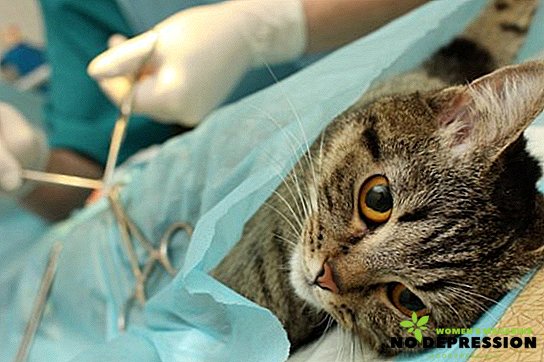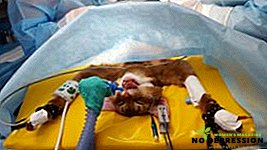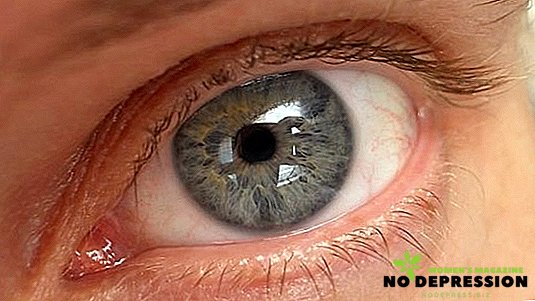Sterilization of cats - a question that still worries many. Some owners are happy to agree on the operation, others believe that it will harm the animal. Therefore, it is necessary to familiarize yourself with the advantages and disadvantages of such an operation, and how it is carried out.

Reasons for sterilization
This type of surgery leads to a decrease or complete cessation of the production of the hormone estrogen, which is responsible for sexual activity. The behavior of cats during estrus becomes a real torture for the owners.
Sexual reflexes during this period do not find a natural way out, and the owners have to put up with skating on the floor, meowing, obsessive caress or bouts of aggression. If, however, to release the animal on the street, a cat, having satisfied its desire, will inevitably bring posterity.
Pros and cons of sterilization
According to long-term observations of veterinarians, professionally performed sterilization prolongs cat life, and does not shorten it. But this operation has both advantages and disadvantages.
Advantages of sterilization
The main advantage is that sterilization is the most humane method of regulating the number of stray animals.
People who allow their cat to constantly give birth, and then throw kittens to other people or throw them out on the street, have a very vague idea of a good attitude to animals. In order to avoid such horrible situations it is necessary to sterilize your cat.
The second very important moment for a cat is its lifespan and state of health. On average, sterilized animals live for 2-4 years longer than those who have avoided such an operation. The pity of the owners, who do not want their pets to be slaughtered, and instead prefer to give drops and tablets to the animal during estrus, is often very expensive for cats. Those who once faced an oncological disease in an animal are unlikely to go this way.
 Often estrus without breeding in cats is accompanied by hormonal surges, which damages the health of the animal. In a five-year non-breeding cat, the risk of cancer, as well as uterine abscess, polycystic cytosis, vulvovaginitis and some other pathologies increases several times. At the same time, the cat's body, which can give birth as much as it wants, is under serious stress, quickly wears out, not to mention the natural risks of the birth process.
Often estrus without breeding in cats is accompanied by hormonal surges, which damages the health of the animal. In a five-year non-breeding cat, the risk of cancer, as well as uterine abscess, polycystic cytosis, vulvovaginitis and some other pathologies increases several times. At the same time, the cat's body, which can give birth as much as it wants, is under serious stress, quickly wears out, not to mention the natural risks of the birth process.
The advantage of sterilizing a cat includes such a factor as reducing the thirst for traveling long distances. This is especially true for those animals that are free-range. Sterilized pets deliver less hassle to their owners, rarely come into contact and fight with other animals, thereby reducing the risk of injury or infection.
There are some pluses for cat owners: the absence of meowing concerts, the absence of unpleasant manifestations of sexual hunting, more tender and calm behavior.
Cons sterilization
Sterilization is still an operation. Therefore, there is a risk of complications both after anesthesia and after surgery. To prevent anesthesia from harm, an animal must be examined before the operation and a biochemical blood test is taken. And in order that the postoperative suture does not become inflamed and not rotten, it is necessary to perform an operation in the clinic, and after it is carried out, follow all the recommendations of the doctor. Often, cats are naughty and tuned against wearing a special collar. However, you need to understand the need for its use.
Also, the minus of the operation is a possible increase in the appetite of a sterilized cat with a decrease in energy needs. Such animals are not only at risk of obesity, but also its consequences in the form of diabetes, urolithiasis, heart disease, and allergies. To avoid such cases, you need to reduce the portions and purchase special food for neutered and sterilized pets.
It is better to sterilize a cat at a young age, between the second and third estrus, which will minimize the risk of dangerous consequences.
Preparing for surgery
Sterilization is a serious surgical procedure that is performed under general anesthesia. This process requires a lot of responsibility from the owner of the animal. He needs to listen carefully to the doctor’s recommendations and follow all his instructions.
For his part, the doctor must be sure that his patient will undergo surgery well and without complications. To avoid unexpected difficulties in performing surgery, before the operation, the doctor can refer the cat to a general practitioner, cardiologist, an ultrasound scan, and prescribe a series of tests. Such precautions are very important when working with cats, which are already quite a few years old, since they often have cardiac and other internal pathologies, for example, inflammatory processes, tumors, and so on.
Also, before the operation, the owner of the cat must put her on a special diet, which implies the absence of feed for 12 hours and water for 3 hours before the operation. With a complete digestive tract, vomiting may start in a cat during the administration of an anesthetic for the cat, and vomit may also enter the respiratory tract, which may lead to infection of the bronchi by bacteria. This often leads to aspiration pneumonia, and a weakened animal’s body is difficult to cope with the disease.
Types of medical intervention
A variety of methods will help to cope with sexual activity, but sterilization and castration are considered the most cardinal and effective.
Sterilization
Under this term, veterinarians understand the surgical removal of the ovaries (ovariectomy). This method further prevents the appearance of tumors and cysts, is shown to young and feline cats with a healthy uterus. The truth is to remember that after the procedure, purulent processes can often begin in the uterus, endometritis or pyometra can occur. Older cats with diseases of the reproductive system, most often do castration.
 Castration
Castration
This operation, best known as ovariohysterectomy, involves removal of the ovaries and uterus. Castration can be carried out according to plan or according to indications, such as dysfunctional labor, diseases of the uterus, and so on.
This procedure is shown to animals of different ages. With castration, many health problems disappear, for example, malfunction of the reproductive organs.
Tubal occlusion
This surgical intervention, which involves the ligation of the fallopian tubes, is similar in force to the body to sterilization and castration, but the genital organs are not removed. When tubal occlusion remains estrus, the behavior during estrus and reflex search partner, but there is no risk of becoming pregnant. This method is used extremely rarely, since this operation does not remove the undesirable manifestation of estrus.
Chemical castration
This method is recommended for those who are still planning to pair their cat, but later. Chemical castration is temporary, consists in the introduction of implants under the skin. At the end of its action, the animal will again be able to have healthy offspring.
How is the surgery going?
Both sterilization and castration are most often carried out in three ways, differing from each other only by penetrating the abdominal region.
Through the middle section
The incision in this operation, which is carried out along the white line of the abdomen, reaches about 2.5 cm. It all depends on the size of the cat, the qualifications of the doctor and associated diseases. The operation is as follows:
- the hair is shaved from the navel to the final pair of nipples;
- further cut the skin;
- muscles sever in a blunt way.
Then the surgeon removes the ovaries from the uterus or the ovaries only. Stitches are laid on the abdominal wall. To avoid divergence of stitches and wound infection, the animal should be put on a postoperative blanket. It is removed on the same day as the stitches.
Castration side access
This method is more often used for castration and is attractive because the incision is smaller in comparison with the traditional operation. And postoperative recovery is faster. The cat, waking up after anesthesia, can immediately be released into the external environment.
But there are also disadvantages: the muscles are restored painfully, because the connective tissue is restored much easier with normal sterilization. In addition, surgeons do not particularly like this method, since they cannot vouch for the condition of the internal organs in order to recommend further diagnosis and treatment. Access through a side incision is most often used to sterilize stray animals.
Laparoscopic sterilization
It is the safest method. The disadvantages include the high cost due to the need to use serious equipment. The advantages include maximum sterility, a small amount of injured tissue, excellent visualization for the assessment of postoperative risks, minimal treatment of sutures.

When punctured with a trocar, the resulting wound is simply sealed. Postoperative treatment is not required.
How is the postoperative period
It takes about 7-15 days to recover from sterilization. If the owners do not have the opportunity to care for the animals during this period due to lack of time or desire, you can use the services of a veterinarian. When the animal is brought home after the operation, it should be placed on the floor away from protruding corners. You should put a diaper on the litter, as the cat may begin vomiting or involuntary urination.
Being still under the influence of anesthesia, cats often start walking, jumping on high objects, which is very dangerous due to the lack of coordination. Until the effect of anesthesia is over, you must be close to the animal. It is recommended that the cat should wear a blanket and make sure that it is warm, as anesthesia causes a decrease in body temperature. Periodically, you need to look at how the surgical site heals, and monitor the tightness of the blankets. It happens that due to excessive licking of the blanket can shift and the cat can get to the wound.
It is important to ensure that the wound does not begin to fester, bleed. During this period, it should be lubricated with antiseptic ointments or liquids, such as Chlorhexidine. Long-acting antibiotics, such as Amoxoil or Amoxicillin, may also be given. Most often put 2 injections with a break in two days. The owner must make the second injection on his own or bring the animal back to the hospital.


 Castration
Castration









